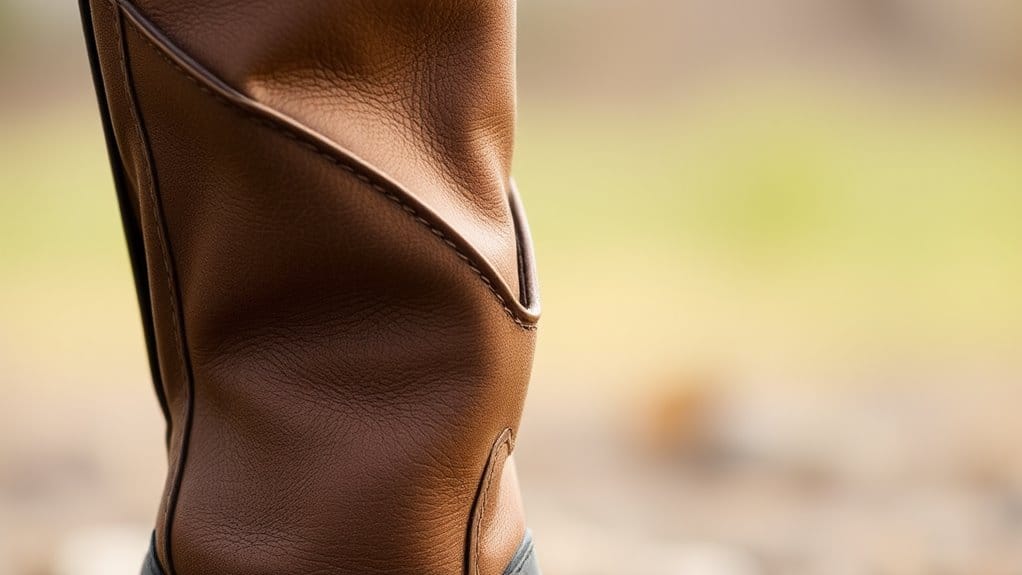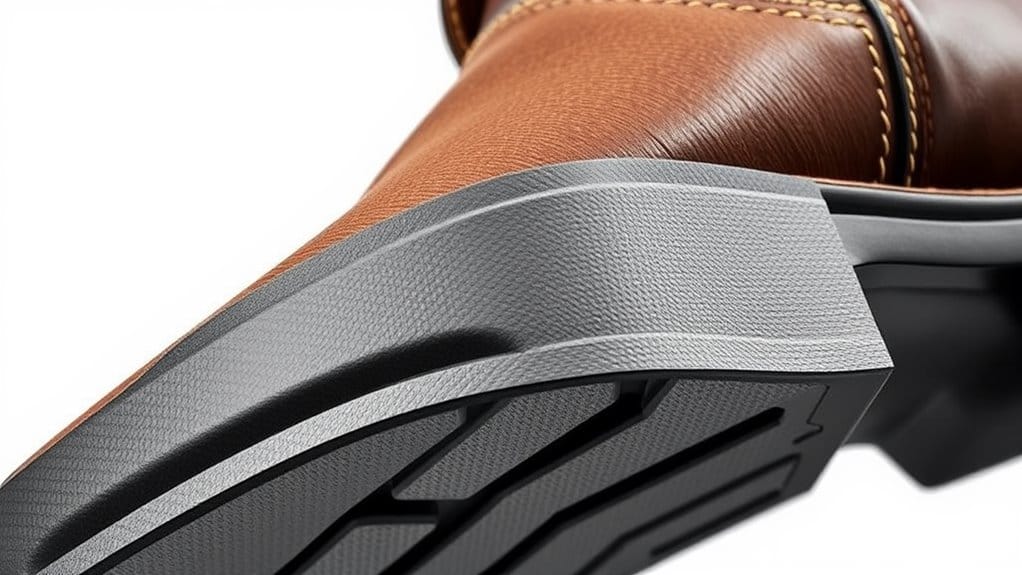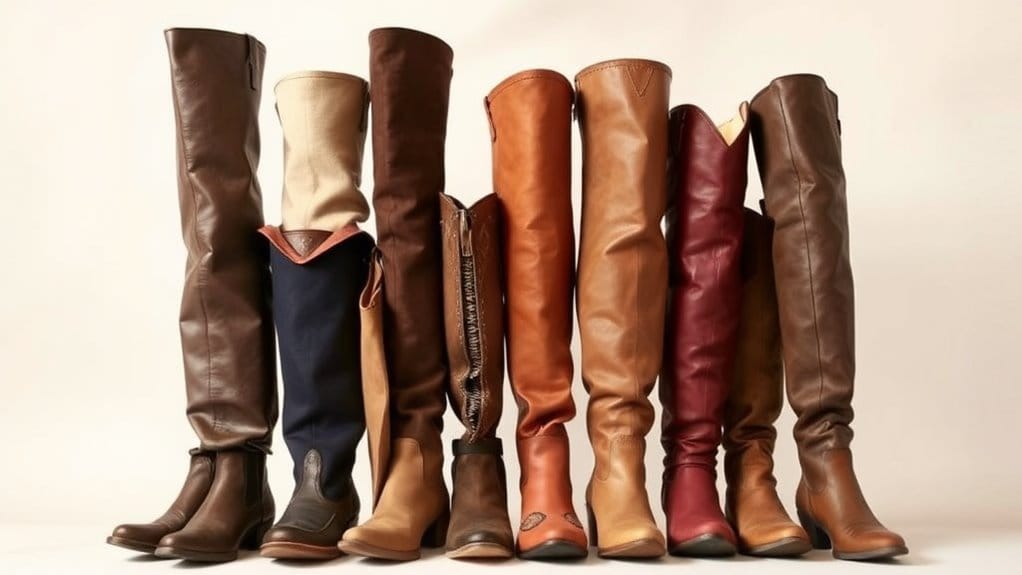This post contains affiliate links. As an Amazon Associate, we earn from qualifying purchases.
The shaft of a boot is the vertical section that extends from your ankle to the top of the boot. It provides crucial support and protection while also influencing your comfort and mobility. Boot shafts come in various heights—ankle, mid-calf, and knee-high—each catering to different needs and styles. The materials used, from leather to synthetics, impact durability and breathability. There's much more to explore about boot shafts and how they affect your footwear choices.
Key Takeaways
- The shaft of a boot extends from the ankle to the top, providing support and protection during movement.
- It influences comfort, mobility, and stability, allowing for natural foot flexibility.
- Boot shafts come in various heights: ankle, mid-calf, and knee-high, each serving different purposes.
- Materials for shafts include leather and synthetics, affecting breathability, durability, and water resistance.
- Proper care and maintenance of the shaft are essential for longevity and performance.
Definition of the Shaft

The shaft of a boot refers to the part that extends from the ankle to the top of the boot, providing essential support and protection. Understanding shaft functionality is crucial for selecting the right boot for your activities.
A well-designed shaft offers stability, ensuring your ankles are supported during movement. Additionally, shaft flexibility plays a significant role in comfort and performance. A flexible shaft allows for natural foot movement, which is vital for tasks like hiking or running.
When choosing a boot, consider how the shaft's design meets your specific needs, balancing support and flexibility for optimal performance. Whether you're tackling rugged terrain or navigating urban landscapes, the shaft significantly influences your overall experience.
Anatomy of a Boot

Understanding the anatomy of a boot is essential for making informed footwear choices. The boot shaft, a critical component, serves multiple functions, including providing support and protection to your lower leg. Its height and shape can greatly influence your comfort and mobility.
Historically, boot shafts evolved from practical designs, used for protection during rugged activities, to fashionable elements in modern footwear. The boot shaft functionality extends beyond aesthetics; it also plays a role in moisture management and breathability.
Materials like leather, synthetic fibers, or textiles contribute to the boot shaft's structure, enhancing durability and flexibility. By knowing these aspects, you can choose boots that offer the right balance of style and functionality tailored to your needs.
Different Types of Boot Shafts

Boot shafts come in various types, each designed for specific purposes and styles.
You'll encounter shaft variations like ankle, mid-calf, and knee-high, each offering unique aesthetics and functionality. Ankle boots provide a chic, versatile option that aligns well with current fashion trends, making them ideal for both casual and formal occasions.
Mid-calf shafts strike a balance between coverage and style, while knee-high boots offer warmth and striking visual appeal.
Additionally, specialized shafts, such as those found in equestrian or work boots, emphasize durability and support.
Understanding these different types of boot shafts allows you to choose the right pair that not only complements your wardrobe but also meets your practical needs.
The Importance of Shaft Height
While selecting the right pair of boots, shaft height plays a crucial role in both comfort and functionality. Understanding shaft height benefits can greatly enhance your decision-making process.
For instance, taller shafts provide better ankle support and protection against debris, making them ideal for rugged terrains. Conversely, shorter shaft height styles offer increased mobility and breathability, perfect for casual wear or warmer climates. The right choice depends on your intended use, whether it's hiking, work, or everyday fashion.
Additionally, shaft height can influence how well the boot fits inside your pant leg, impacting overall aesthetics. By considering these factors, you'll ensure that your boots not only look great but also perform efficiently for your specific needs.
Materials Used for Boot Shafts
When choosing boots, the materials used for the shaft significantly impact durability, comfort, and performance.
Leather types, such as full-grain, top-grain, and suede, offer varying levels of breathability and water resistance. Full-grain leather is known for its strength and ability to mold to your foot over time, while top-grain leather is more supple and easier to break in. Suede provides a softer feel but may require more care to maintain its appearance.
On the other hand, synthetic options like nylon and polyester offer lightweight durability and often come with moisture-wicking properties. These materials can be more affordable and resistant to abrasions, making them suitable for different environments and activities.
Choosing the right material ensures your boots meet your specific needs.
How Shaft Design Affects Comfort
Shaft design plays a crucial role in determining how comfortable your boots feel during wear. The shaft's height and width impact shaft comfort significantly. A taller shaft can provide extra support, but it may also restrict movement if it's too rigid.
Conversely, a shorter shaft may offer more freedom but less ankle support. Shaft flexibility is equally important; a more flexible shaft allows for natural foot movement, reducing fatigue during extended wear.
Materials like leather or synthetic blends can enhance flexibility, adapting to your foot's shape. When choosing boots, consider how both height and flexibility align with your activities to ensure optimal comfort and support.
Prioritize these factors to enhance your overall boot experience.
Shaft and Fit: Finding the Right Size
Finding the right size for your boot's shaft is essential to achieving a snug fit that supports your foot and ankle without causing discomfort.
Begin by measuring your calf circumference and height to determine appropriate shaft sizing. Make sure to account for any additional layers, like thick socks.
Consider the shaft flexibility as well; a more flexible shaft can accommodate movement, while a stiffer shaft offers added support.
When trying on boots, pay attention to how the shaft feels during walking. A well-fitted shaft should hug your leg without restricting motion.
Style Considerations for Boot Shafts
While selecting boots, it's important to consider the style of the shaft, as it can significantly impact both aesthetics and functionality. The height, shape, and design of the shaft should align with your intended use and fashion trends.
For instance, knee-high shafts can offer a trendy silhouette while providing extra support. Pay attention to shaft embellishments, such as buckles, zippers, or decorative stitching, which can enhance the overall look of your boots.
These details not only reflect your personal style but can also affect how well the boots pair with different outfits. Remember, a well-styled shaft can elevate your appearance while ensuring comfort and practicality in various settings.
Choose wisely to achieve both form and function in your footwear.
Care and Maintenance of Boot Shafts
To ensure your boot shafts last, you'll need effective cleaning techniques and proper conditioning materials.
Start by regularly removing dirt and moisture to prevent deterioration.
Then, apply suitable conditioners to maintain flexibility and extend the lifespan of the materials.
Cleaning Techniques for Shafts
Proper care and maintenance of boot shafts can significantly extend their lifespan and performance.
To keep your boot shafts in top condition, start by selecting appropriate cleaning products based on the material—leather, synthetic, or fabric. Use a damp cloth to wipe off dirt and grime, ensuring you don't saturate the material.
For deeper cleaning, consider specialized cleaning products designed for your boot's material. Employ gentle cleaning methods, such as soft brushes for stubborn stains, to avoid damaging the surface.
After cleaning, allow your shafts to air dry away from direct sunlight or heat sources.
Regularly cleaning your boot shafts not only preserves their appearance but also enhances their durability and functionality, ensuring they serve you well over time.
Conditioning Materials for Longevity
Conditioning your boot shafts is essential for maintaining their flexibility and preventing premature wear. Start by selecting appropriate conditioning techniques that suit your boot material, whether it's leather, synthetic, or fabric.
For leather shafts, use a high-quality leather conditioner to keep the material supple and resistant to cracking. Synthetic materials may benefit from specialized creams or sprays designed to enhance durability.
Additionally, applying protective treatments, such as waterproofing sprays, can shield your boots from moisture and stains.
Regularly assess the condition of your boot shafts and reapply conditioning products as needed, especially after exposure to harsh environments.
Popular Boot Styles and Their Shafts
Boots come in a variety of styles, each with distinct shaft designs that influence both functionality and aesthetics.
For instance, ankle boots feature shorter shafts, offering flexibility and ease of wear, which aligns with current fashion trends. Mid-calf boots provide a balance between coverage and versatility, making them suitable for various outfits.
On the other hand, knee-high boots deliver maximum style impact and warmth, often seen in seasonal collections. The shaft's material and structure can also affect comfort, especially during long wear.
Understanding these differences enhances your boot versatility, allowing you to choose the right pair for any occasion while staying fashionable.
Frequently Asked Questions
How Do I Clean and Maintain My Boot Shaft?
To clean and maintain your boot shaft, use proper boot care techniques. Gently wipe with a damp cloth, apply appropriate cleaners, and condition the material regularly to preserve its integrity and appearance. Avoid harsh chemicals.
Can I Customize the Shaft Height of My Boots?
Yes, you can customize the shaft height of your boots. Many brands offer customization options, allowing you to specify shaft measurements for a perfect fit, enhancing both comfort and style tailored to your needs.
What Types of Footwear Feature Boot Shafts?
You'll find boot shafts on various footwear types, including dress boots designed for formal occasions and work boots built for durability and protection. Each type offers unique features tailored to specific environments and activities.
How Does Shaft Stiffness Affect Boot Performance?
Shaft stiffness directly influences boot performance. Increased shaft flexibility enhances mobility and comfort, while greater stiffness provides superior boot support, stabilizing your ankle during activities. Finding the right balance is crucial for optimal performance in various conditions.
Are There Specific Boot Shafts for Different Weather Conditions?
Yes, specific boot shafts cater to different weather conditions. You'll find insulated boot shafts for cold climates and weather-resistant materials for wet environments, ensuring optimal performance and comfort in varying temperatures and conditions.
Conclusion
In summary, the shaft of a boot plays a crucial role in both fit and functionality. Understanding its definition, anatomy, and various types helps you choose the right pair for your needs. Consider the importance of shaft height, materials, and style to ensure optimal comfort and performance. By prioritizing these factors and maintaining your boots properly, you can enhance their longevity and keep your feet well-supported, whether you're at work or enjoying outdoor activities.



